
The third USS Hornet was a brig-rigged sloop-of-war in the United States Navy. During the War of 1812, she was the first U.S. Navy ship to capture a British privateer.

The first John Adams was originally built in 1799 as a frigate for the United States Navy, converted to a corvette in 1809, and later converted back to a frigate in 1830. Named for American Founding Father and president John Adams, she fought in the Quasi-War, the First and Second Barbary Wars, the War of 1812, the Mexican–American War and the American Civil War.

The Pacific Squadron was part of the United States Navy squadron stationed in the Pacific Ocean in the 19th and early 20th centuries. Initially with no United States ports in the Pacific, they operated out of storeships which provided naval supplies and purchased food and obtained water from local ports of call in the Hawaiian Islands and towns on the Pacific Coast. Throughout the history of the Pacific Squadron, American ships fought against several enemies. Over one-half of the United States Navy would be sent to join the Pacific Squadron during the Mexican–American War. During the American Civil War, the squadron was reduced in size when its vessels were reassigned to Atlantic duty. When the Civil War was over, the squadron was reinforced again until being disbanded just after the turn of the 20th century.
USS Germantown was a United States Navy sloop-of-war in commission for various periods between 1847 and 1860. She saw service in the Mexican–American War in 1847–1848 and during peacetime operated in the Caribbean, in the Atlantic Ocean off Africa and South America, and in East Asia. Scuttled at the outbreak of the American Civil War in 1861, she was captured and refloated by the Confederate States of America and placed in service with the Confederate States Navy as the floating battery CSS Germantown before again being scuttled in 1862.

USS Peacock was a sloop-of-war in the United States Navy that served in the War of 1812 and later the United States Exploring Expedition. Peacock ran aground and broke apart on the Columbia Bar without loss of life in 1841.

The Mediterranean Squadron, also known as the Mediterranean Station, was part of the United States Navy in the 19th century that operated in the Mediterranean Sea. It was formed in response to the First and Second Barbary Wars. Between 1801 and 1818, the squadron was composed of a series of rotating squadrons. Later, squadrons were sent in the 1820s to the 1860s to suppress piracy, primarily in Greece and to engage in gunboat diplomacy. In 1865 the force was renamed the European Squadron.
The first USS Porpoise was a topsail schooner in the United States Navy.

The third USS Alligator was a schooner in the United States Navy.
USS Nonsuch was a moderately successful privateer built in 1812 and then an armed schooner in the United States Navy during the War of 1812. She was sold for breaking up in 1826.

The second USS Lexington was a sloop in the United States Navy built at the New York Navy Yard in Brooklyn, New York, in 1825; and commissioned on 11 June 1826, Master Commandant William B. Shubrick in command.

The first USS Jamestown was a sloop-of-war in the United States Navy during the Mexican–American War and the American Civil War.
USS Onkahye was a topsail schooner of the United States Navy. A unique ship in the American Navy under sail, the vessel occupied a significant place in ship development, being the only converted sailing yacht to serve on a distant station before the American Civil War. Its design was influential and it is considered the model for modern American sailing yachts.
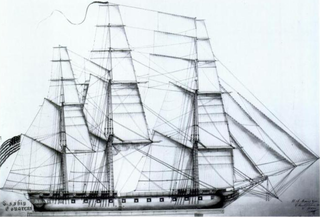
The West Indies Squadron, or the West Indies Station, was a United States Navy squadron that operated in the West Indies in the early nineteenth century. It was formed due to the need to suppress piracy in the Caribbean Sea, the Antilles and the Gulf of Mexico region of the Atlantic Ocean. This unit later engaged in the Second Seminole War until being combined with the Home Squadron in 1842. From 1822 to 1826 the squadron was based out of Saint Thomas Island until the Pensacola Naval Yard was constructed.
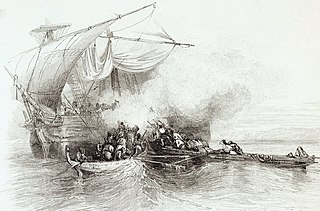
Aegean Sea anti-piracy operations began in 1825 when the United States government dispatched a squadron of ships to suppress Greek piracy in the Aegean Sea. The Greek civil wars of 1824–1825 and the decline of the Hellenic Navy made the Aegean quickly become a haven for pirates who sometimes doubled as privateers.
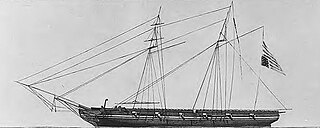
The West Indies Anti-Piracy Operations were a series of military operations and engagements undertaken by the United States Navy against pirates in and around the Antilles. Between 1814 and 1825, the American West Indies Squadron hunted pirates on both sea and land, primarily around Cuba and Puerto Rico. After the capture of Roberto Cofresi in 1825, acts of piracy became rare, and the operation was considered a success, although limited occurrences went on until slightly after the start of the 20th century.

The USS Firefly, was a brig with two masts, square-rigged, formerly named Volant and originally built as a schooner for use as a privateer. The U.S. Navy purchased Volant on 8 December 1814 at New York by and was fitted her out as US naval 14-gun brig. She served during the War of 1812 and Second Barbary War of 1815. Firefly was purchased because of the several US blockade efforts where smaller ships with better maneuverability were needed for the task. The Navy sold her in 1816 and she became a Portuguese slave ship.
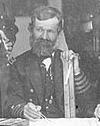
Rear Admiral George Henry Cooper was an officer in the United States Navy. During his long naval career, he served on the African Slave Trade Patrol, and fought in the Second Seminole War, the Mexican War, the American Civil War, and the Korean Expedition, and rose to command of the North Atlantic Squadron.
USS Ferret was a two masted schooner, the third U.S. Navy vessel to bear this name, and was purchased 20 December 1822 at Baltimore, Maryland and commissioned early in 1823, with Lieutenant R. Henley in command. It was the first U.S. naval ship commanded by the famous naval hero David Farragut. Ferret served transporting U.S. sailors, marines and supplies to the pirate infested waters of the Caribbean and was used to search out and attack pirate ships and pirate strongholds for a little more than two years when her career was cut short when the vessel capsized in a gale force storm off the coast of Cuba.
James D. Saules was a sailor of the United States Exploring Expedition. In 1841 he survived the sinking of the USS Peacock at the Columbia Bar. Saules subsequently was among the first black settlers of the Oregon Country. While residing in the Willamette Valley he became involved in the Cockstock incident.
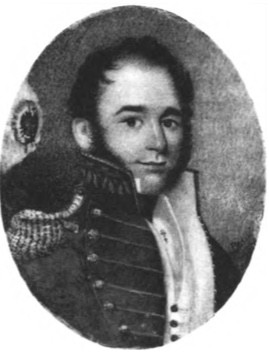
Thomas Jefferson Leib was an American naval officer of the early 19th-century sailing ship era, active in Florida's Second Seminole War as well as anti-piracy and smuggling suppression patrols throughout the Gulf of Mexico, Caribbean Sea, and West Indies.














